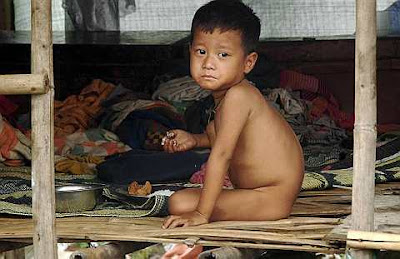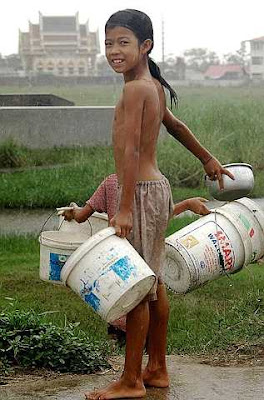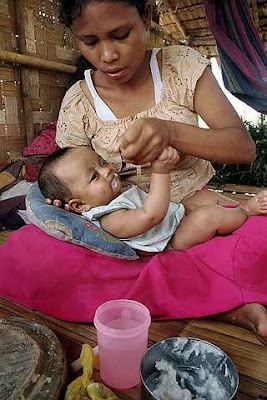
A child affected by cyclone Nargis looks on as he eats a meal in Dagon township on the outskirts of Yangon on 15, May 2008. Most victims of Myanmar's devastating cyclone remain without emergency food nearly two weeks after the storm, aid agencies said on May 15 although life-saving goods are slowly snaking out to survivors.

A woman carries an injured survivor of cyclone Nargis in Dagon township on the outskirts of Yangon on 15, May 2008. Most victims of Myanmar's devastating cyclone remain without emergency food nearly two weeks after the storm, aid agencies said on May 15 although life-saving goods are slowly snaking out to survivors.

People affected by the cyclone Nargis find shelter inside a primary school in North Okkalapa township on the outskirts of Yangon on May 15, 2008. Most victims of Myanmar's devastating cyclone remain without emergency food nearly two weeks after the storm, aid agencies said on May 15 although life-saving goods are slowly snaking out to survivors.

A woman carrying a bag of food and a pair of shoes walks past a house destroyed by cyclone Nargis on the outskirts of Yangon on May 15, 2008. Most victims of Myanmar's devastating cyclone remain without emergency food nearly two weeks after the storm, aid agencies said on May 15 although life-saving goods are slowly snaking out to survivors.

A boy sits on an uprooted tree which he uses as a temporary shelter on the outskirts of Yangon on May 15, 2008. Most victims of Myanmar's devastating cyclone remain without emergency food nearly two weeks after the storm, aid agencies said on May 15 although life-saving goods are slowly snaking out to survivors.

People affected by cyclone Nargis scavenge a piece of wood in Dagon township on the outskirts of Yangon on 15, May 2008. Most victims of Myanmar's devastating cyclone remain without emergency food nearly two weeks after the storm, aid agencies said on May 15 although life-saving goods are slowly snaking out to survivors.

A boy affected by cyclone Nargis carries bucket for water in Dagon township on the outskirts of Yangon on 15, May 2008. Most victims of Myanmar's devastating cyclone remain without emergency food nearly two weeks after the storm, aid agencies said on May 15 although life-saving goods are slowly snaking out to survivors.

This picture taken 14 May 2008 shows two dead bodies of victims of the cyclone Nargis on Main Ma Hla island near in Bogalay in the Irrawaddy Division of Myanmar. The UN called an emergency summit on Myanmar's aid crisis on May 15, 2008 as the junta dug in its heels two weeks after a deadly cyclone, saying it would not bow to pressure to let in foreign aid workers.

People affected by the cyclone Nargis walk past an uprooted tree in Yangon on May 15, 2008. The UN called an emergency summit on Myanmar's aid crisis on May 15, 2008 as the junta dug in its heels two weeks after a deadly cyclone, saying it would not bow to pressure to let in foreign aid workers.

Villagers are seen near houses destroyed by the cyclone Nargis in Pyapon township in the Ayeyarwady division of Myanmar on May 15, 2008. As state media raised the death toll to 43,318, with nearly 28,000 still missing and another two million in dire need of help, Myanmar's southeast Asian neighbors geared up for talks aimed at convening a high-level donors meeting.

People displaced by cyclone Nargis sit on the side of a road between Pyapon township and Yangon in the Ayeyarwady division of Myanmar on May 15, 2008. As state media raised the death toll to 43,318, with nearly 28,000 still missing and another two million in dire need of help, Myanmar's southeast Asian neighbors geared up for talks aimed at convening a high-level donors meeting.

People affected by the cyclone Nargis find shelter inside a primary school in North Okkalapa township on the outskirts of Yangon on May 15, 2008. Most victims of Myanmar's devastating cyclone remain without emergency food nearly two weeks after the storm, aid agencies said on May 15 although life-saving goods are slowly snaking out to survivors.





